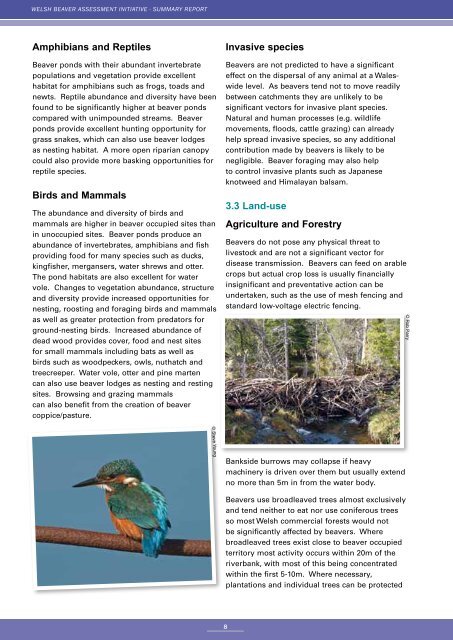Beaver-Summary-report-English
Beaver-Summary-report-English
Beaver-Summary-report-English
Create successful ePaper yourself
Turn your PDF publications into a flip-book with our unique Google optimized e-Paper software.
WELSH BEAVER ASSESSMENT INITIATIVE - SUMMARY REPORT<br />
Amphibians and Reptiles<br />
<strong>Beaver</strong> ponds with their abundant invertebrate<br />
populations and vegetation provide excellent<br />
habitat for amphibians such as frogs, toads and<br />
newts. Reptile abundance and diversity have been<br />
found to be significantly higher at beaver ponds<br />
compared with unimpounded streams. <strong>Beaver</strong><br />
ponds provide excellent hunting opportunity for<br />
grass snakes, which can also use beaver lodges<br />
as nesting habitat. A more open riparian canopy<br />
could also provide more basking opportunities for<br />
reptile species.<br />
Birds and Mammals<br />
The abundance and diversity of birds and<br />
mammals are higher in beaver occupied sites than<br />
in unoccupied sites. <strong>Beaver</strong> ponds produce an<br />
abundance of invertebrates, amphibians and fish<br />
providing food for many species such as ducks,<br />
kingfisher, mergansers, water shrews and otter.<br />
The pond habitats are also excellent for water<br />
vole. Changes to vegetation abundance, structure<br />
and diversity provide increased opportunities for<br />
nesting, roosting and foraging birds and mammals<br />
as well as greater protection from predators for<br />
ground-nesting birds. Increased abundance of<br />
dead wood provides cover, food and nest sites<br />
for small mammals including bats as well as<br />
birds such as woodpeckers, owls, nuthatch and<br />
treecreeper. Water vole, otter and pine marten<br />
can also use beaver lodges as nesting and resting<br />
sites. Browsing and grazing mammals<br />
can also benefit from the creation of beaver<br />
coppice/pasture.<br />
© Steve Young<br />
8<br />
Invasive species<br />
<strong>Beaver</strong>s are not predicted to have a significant<br />
effect on the dispersal of any animal at a Waleswide<br />
level. As beavers tend not to move readily<br />
between catchments they are unlikely to be<br />
significant vectors for invasive plant species.<br />
Natural and human processes (e.g. wildlife<br />
movements, floods, cattle grazing) can already<br />
help spread invasive species, so any additional<br />
contribution made by beavers is likely to be<br />
negligible. <strong>Beaver</strong> foraging may also help<br />
to control invasive plants such as Japanese<br />
knotweed and Himalayan balsam.<br />
3.3 Land-use<br />
Agriculture and Forestry<br />
<strong>Beaver</strong>s do not pose any physical threat to<br />
livestock and are not a significant vector for<br />
disease transmission. <strong>Beaver</strong>s can feed on arable<br />
crops but actual crop loss is usually financially<br />
insignificant and preventative action can be<br />
undertaken, such as the use of mesh fencing and<br />
standard low-voltage electric fencing.<br />
Bankside burrows may collapse if heavy<br />
machinery is driven over them but usually extend<br />
no more than 5m in from the water body.<br />
<strong>Beaver</strong>s use broadleaved trees almost exclusively<br />
and tend neither to eat nor use coniferous trees<br />
so most Welsh commercial forests would not<br />
be significantly affected by beavers. Where<br />
broadleaved trees exist close to beaver occupied<br />
territory most activity occurs within 20m of the<br />
riverbank, with most of this being concentrated<br />
within the first 5-10m. Where necessary,<br />
plantations and individual trees can be protected<br />
© Rob Parry


